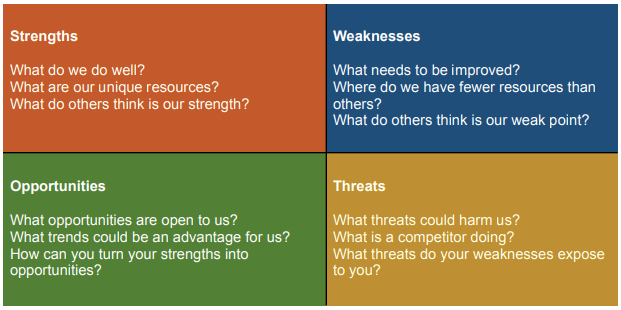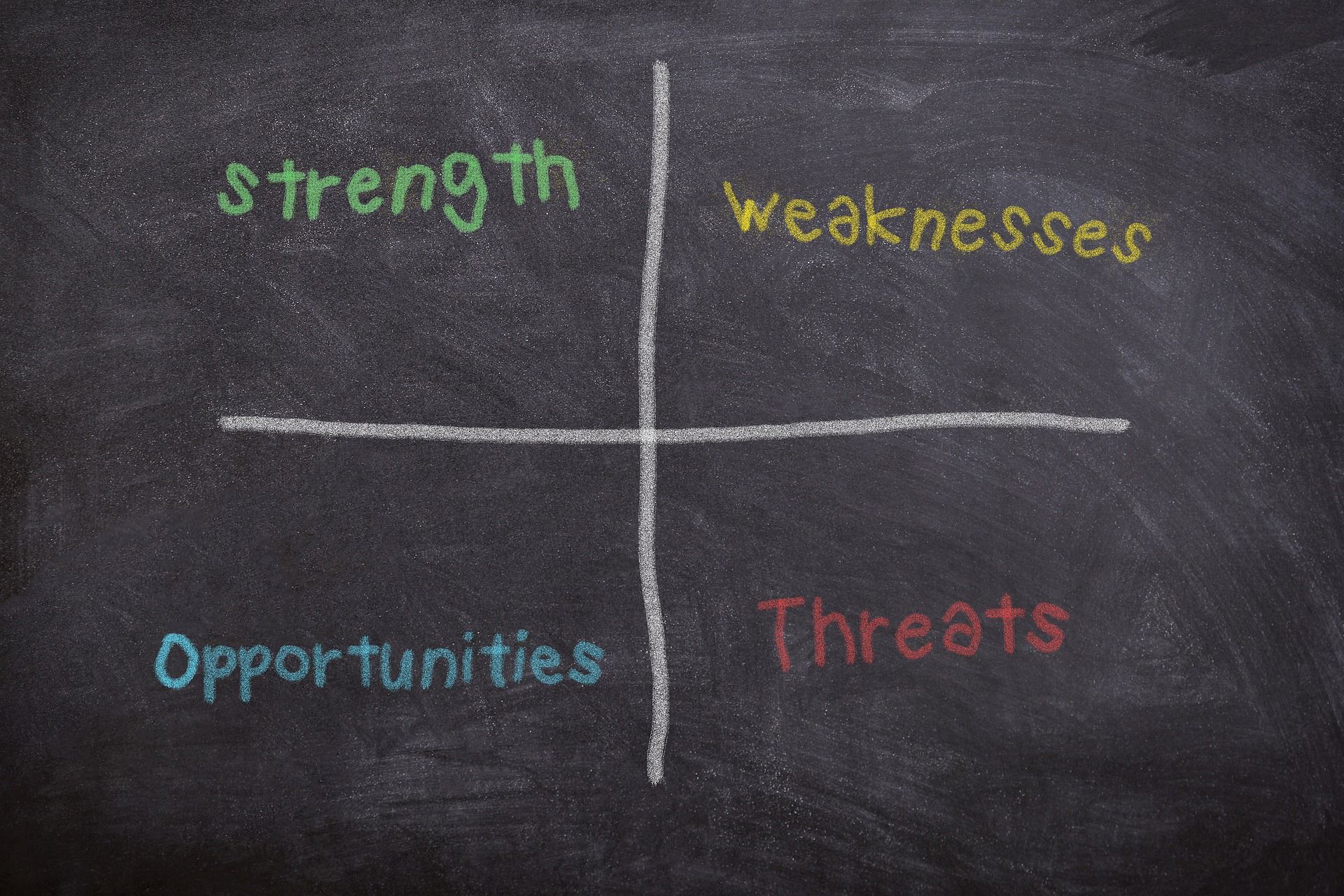To survive and grow in this competitive business world, it is a necessity for every management to carry out a SWOT analysis for their respective business organizations.

It is a process by which companies monitor their relevant environment to identify their strengths, weaknesses, opportunities, and threats. SWOT analysis or environment analysis will help us develop a business model that would accurately bring into line the company’s resources and capabilities.
What is SWOT Analysis?
SWOT (Strength, Weakness, Opportunity, and Threat) analysis is a study that is undertaken by an organization to identify its internal strengths and weaknesses. Along with its external opportunities and threats. A SWOT analysis is a technique for assessing a project or business venture by focusing on each of these factors.
SWOT analysis helps us to analyze what our company is best at and formulate a successful strategy for the future. It can also show us the areas where our company is holding back, or those our competitors might exploit if we did not protect them for ourselves.
This analysis makes it easier for us to decide whether to move forward with the project or not, by outlining all aspects of a project. This analysis is also intended to aid an idealistic, fact-based, and data-driven look at the strengths and weaknesses of an organization, its initiatives, or within its industry.
Every organization needs to keep the SWOT analysis accurate by focusing on the real-life context and avoiding preconceived beliefs or uncertainties. They should instead focus on real-life contexts. Companies should make use of the SWOT analysis as a guide.
This article will help you understand how to do a SWOT analysis. It will also assist us on how to put the findings from a SWOT analysis into action. We have also included an example for a better understanding of the topic.
How to Conduct a SWOT Analysis?
Let us look at the steps for conducting SWOT Analysis:
Step 1: Determine the Objective for SWOT Analysis
In order to start the SWOT analysis, there should be a question or an objective in our minds. Finding this objective is the first and the most important step in conducting a SWOT analysis. For example, the question can be whether to introduce a new product or service or change our existing process.
Step 2: Research your Business, Industry, and Market
Before beginning with the SWOT analysis, we should do some research on our business, industry, and market. For this, we should get a range of viewpoints by interacting with our staff, business partners, and clients. Also, we should conduct research to find out about the competitors.
Step 3: Draw a SWOT Analysis Matrix
A SWOT analysis matrix is a square divided into four parts, each part representing an element of SWOT (Strengths, Weaknesses, Opportunities, and Threats) respectively in each column. The below figure (fig.1) shows an idea of how it should look.
Strengths
- What do we do well?
- What are our unique resources?
- What do others think is our strength?
Opportunities
- What opportunities are open to us?
- What trends could be an advantage for us?
- How can you turn your strengths into opportunities?
Step 4: List the Strengths of the Business
Weaknesses
- What needs to be improved?
- Where do we have fewer resources than others?
- What do others think is our weak point?
Threats
- What threats could harm us?
- What is a competitor doing?
- What threats do your weaknesses expose you to?
The next important step in conducting a SWOT analysis is to list all the strengths our business has. The qualities that enable every organization to accomplish its mission are known as strengths.
These are internal to an organization and can be tangible or intangible. Strengths are the distinct features, beneficial aspects, or capabilities that an organization excels in. Example: Customer goodwill, brand loyalty, abundant financial resources, committed employees, broad product line, etc.
Step 5: List the Weaknesses of the Business
List the disadvantages that are in our business that we consider as weaknesses. These are the factors that hinder an organization from performing at its optimal level.
For example, absence of new products, employee turnover, higher debt level, lack of capital, lack of intellectual property, inadequate supply chain, etc. In short, weaknesses are those areas where our business needs an improvement in order to remain unshaken in the market.
Step 6: List the Potential Opportunities of the Business
List all the favorable external factors that are available to the business. These are distinct from the internal strengths and are not always the same for different organizations.
An opportunity for one company can be a threat to another. Opportunities are those factors that give a competitive advantage to a company. For example, a new technology, a diverse marketplace, favorable changes in government policies, etc.
Step 7: List the Threats of the Business
Anything and everything that negatively affects your business is called the threat. These are the factors or problems that affect an organization from the outside. A company needs to identify these threats and take necessary steps against them before becoming a victim of them. For example, supply chain problems, change in the market, rise in unemployment, higher interest rates, increasing competition, etc.
Step 8: Establish Priorities from the SWOT Analysis
Once the above steps in drawing a SWOT analysis are complete, we have to analyze every aspect of it in detail. Be sure to note if the positive aspects weigh more than the negative ones. If it does, then carrying out the objective of the SWOT analysis will be a good decision. If it does not, then adjustments should be done, or else the plan must simply be abandoned.
Uses of SWOT Analysis
SWOT analysis helps an organization get a clear view of its strengths, allowing us to focus on them and meet the business objectives. Helps in highlighting the weaknesses of the company and provides the analysts a chance to rectify them. It also showcases possible opportunities that lie ahead.
With the help of SWOT analysis, we can identify strategies that are used to create a business model according to the resources and capabilities available within our company. It views both positive and negative factors which affect the success of the firm that are inside and outside the firm.
The analysis also helps the company to forecast and predict changing trends that benefit the decision-making process of any organization. Benefits of SWOT analysis includes the following:
1. Cost-Effective
There is no need for any extensive training or technical skills to conduct a SWOT analysis. In addition, we do not require an external consultant. All you will need is a staff who will have prior knowledge of the business.
2. Wide Range of Applications
SWOT analysis can be used to conduct strategic planning, competitive analysis, or any other study. Through SWOT analysis, our company can recognize its environmental factors which might play favorable or unfavorable roles in any particular objective.
3. Visual Overview of the Positive and Negative Aspects of the Company:
A SWOT analysis is usually presented in a square divided into four equal parts, each representing one factor of the SWOT. The visual arrangement of strengths, weaknesses, opportunities, and threats of a company helps us get a quick overview of our company’s position. This also helps us to determine the success and progress of our company by maximizing its strengths and minimizing its weaknesses.
4. Provides Good Insights
SWOT analysis can be used to gain insights into the market, industry, and the company. This helps us in better understanding our competition. This also gives us the opportunity to formulate a better plan to craft a comprehensible and competitive position in the market and industry.
5. Integration and Synthesis
SWOT analysis gives us the opportunity to combine various quantitative and qualitative information. It helps us to organize and arrange all the information that is already available or that has been acquired during the period. SWOT analysis deals with a wide range of information sources. This helps businesses to transform their weaknesses into possible strengths.
6. Helps in Creating a Better Working Environment
SWOT analysis increases the open exchange of information between different functional areas of an organization. This helps everyone in the organization to understand their weak points, which helps the analyst to solve the problems, eliminate the disagreements, and forester a better working environment.
When Should You Perform a SWOT Analysis?
A SWOT analysis can be conducted before doing any sort of company action. A company action can be considering an opportunity, exploring new initiatives, revision of existing company
policies, etc. Sometimes it is wise to conduct SWOT analysis just to check our current business status and improve the operations as required. This analysis can show us the key areas where our company is performing optimally and the areas where we need improvement.
Instead of wasting our time thinking about your business in an informal way and staying in the hope that everything will come together cohesively, conduct a SWOT analysis. A good SWOT analysis shows us the whole picture of our business. From there, we can discover ways to eradicate or mend the weaknesses and make the most of our company’s strengths.
It is often helpful to include the business owner and team members in the process of creating a SWOT analysis. Make use of brainstorming to list ideas on the current stand of our organization. The collective information provided by all the members of the business will help you to analyze your business from all sides.
SWOT Analysis Example
Let us look at some of the examples of
Example 1: SWOT Analysis of a Well Established Shop

As per the above SWOT analysis, it is clear that the shopping market’s main strengths lie in its sales staff, location, and marketing strategies. The experienced sales staff and their communication skills allow offering excellent customer services to the large client base.
A company’s weaknesses can also be related to its huge size. It will have to employ more employees in order to handle the heavy workload. It will also need to focus on the aspects like rental costs, cash flow, warehouse, and outdated data.
While the company has a great opportunity in offering products to customers based on their demand. The product of the competitors is more expensive when compared with that of our company which helps us to gain more customers.
The threats require the shop owner to have a wide variety of products from which customers can select. It also requires the shop to be up-to-date with new campaigns so that the customers get an idea about the products available there.
Key Takeaways
SWOT analysis enables us to identify our company’s Strengths, Weaknesses, Opportunities, and Threats.
SWOT analysis helps us to improve on what we do well, understand what we are lacking, find out the opportunities that are available and minimize the risks of our business.
We can make use of a SWOT analysis to evaluate our organization’s position before deciding on a new strategy.
Brainstorm and asses all the strengths, weaknesses, opportunities, and threats of an organization based on the objective of the SWOT analysis with the team members.
SWOT analysis help us get a clear image of where the organization stands
Find out what is working well and what is not working well. Ask yourself questions like where you want to go, how to reach there, and what might possibly get in your way as a threat.
While executing the SWOT analysis we should be more realistic and rigorous.
We should also give priority to our ideas, focus our time and money on the most important actions and solutions.
Many firms consider this analysis as the most accurate tool to analyze marketing data and information. Even the simple framework provides a sense of direction and works as a catalyst for the development of the marketing plans for the future. If performed in a correct manner, SWOT analysis not only helps in organizing information and data but also shows us the competitive advantages of our business that can be used to gain leverage over our competitors in the market.
Related Articles











